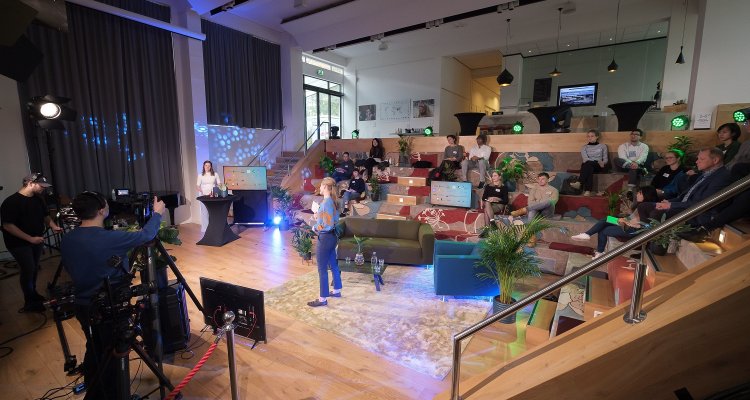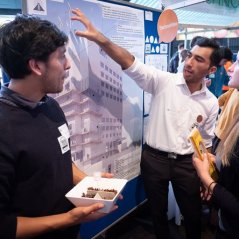Wageningen, The Netherlands
June 27, 2022

This academic year saw student teams from all over the world once again compete to present the best urban agriculture idea. With the Urban Greenhouse Challenge, large student competitions have become an inextricable part of Wageningen.
The final round of the third and last Urban Greenhouse Challenge, organised by WUR, will be held on 29 June. This edition of the challenge attracted thirty student teams from all over the world, bringing together a total of 260 participants. At the event, the jury will announce which of the ten teams in the finals has developed the best urban agriculture idea. The concept must be suitable for one of the poorest and most diverse neighbourhoods in Washington D.C. What have three editions of the Urban Greenhouse Challenge yielded?
To understand the success behind this first Wageningen student challenge, we have to go back to the university's 100th anniversary in 2017. What started as an idea for an event at a party quickly turned into a plan for an annual phenomenon: a multidisciplinary, international competition in which student teams are presented with a concrete challenge. The challenge takes up a large part of the academic year and falls outside the regular study programme.
A first for the life sciences
“Student challenges have been organised by Dutch universities of science and technology for some time,” says organiser Rio Pals. “The World Solar Challenge is the most well known. This involves student teams designing and building an electric car. These kinds of challenges are still rare in the life sciences, or at least there wasn’t anything like it in the Netherlands.” The idea of a life-science challenge appealed to far more students than Pals and her colleague Marta Eggers had imagined, with 23 teams signing up for the first edition straight away. After three editions of the Urban Greenhouse Challenge, the count now stands at 106 teams with more than 1,000 students from 36 countries.
Bijlmer Bajes

The participants in the first edition examined the issue of how urban agriculture could find a place at a specific location in the Netherlands: the former Bijlmer Bajes (a prison). They had to use local resources and energy generated locally. At the same time, the aim was to involve residents in sustainable and healthy food as well as to prove that the plan was technically and financially feasible. The jury therefore assessed the plans not only on the environmental and sustainability aspects, but also on social, economic, and technical aspects.
Next stop: China
The international character was given even more shape in the second and third editions when new locations were chosen. In 2019–2020, the assignment was to design an urban greenhouse for a park in a Chinese city. What made it so challenging to come up with a concept for this? “You start with just a piece of land, nothing else at all”, sums up one participant who designed a 23-storey tower for vertical farming. One of the winning teams designed an innovative building inspired by Taoism, a Chinese philosophical, religious tradition. Food production, research, education, and entertainment come together in the building.
What motivates students to take part
After three editions, awareness of what the Urban Greenhouse Challenge has brought about is declining. Participants found the transdisciplinary teamwork, entrepreneurship, and dealing with complex issues particularly informative. Thanks to the 64 different business partners, participants were able to expand their network and explore career opportunities.
Eggers: “However, those are not the main reasons why students decide to take part. They especially enjoy working on a concrete assignment, which they can complete in their own way. This is something that is different from what they do in their university courses. In a student challenge, they need much more initiative and creativity to come up with an entry.”
Coaches and masterclasses
Companies also increasingly saw the benefits of partnering with the Urban Greenhouse Challenge. From the second edition, they have been more closely involved, offering coaching and masterclasses. “In retrospect, coaches find it incredibly inspiring to guide such driven, creative young people,” says Pals. “Companies get a feel for what the younger generation is doing. This helps them gain new ideas for their own sector. They also do it for PR and to attract the best employees.”
Popularity
Finally, in addition to the crossover between companies and students, Pals and Eggers also noticed an emerging interest in the topic of urban agriculture. “Urban farming has become more popular among young people in recent years,” says Eggers. “Perhaps that is partly thanks to the Urban Greenhouse Challenge. We even heard from some students that they came to Wageningen because of this challenge.” The topic of urban farming is now so alive that the challenge has been followed by the University of Bologna, Italy. A former participant in the Wageningen competition helped with the organisation.
The next challenge: Nature Based Solutions
Over the past five years, the Urban Greenhouse Challenge has alternated twice with the ReThink Protein Challenge. From the coming academic year, it is time for WUR to take on new challenges. The successor to the Urban Greenhouse Challenge will be the Nature Based Solutions Challenge. WUR hopes that the next proverbial seed will be planted, so that this subject will also become popular among young people. Eggers: “We start a discussion and try to inspire students. We want to show people that you can pioneer at WUR.”
Read more about Nature Based Solutions Challenge
De oogst van de Urban Greenhouse Challenge
Studententeams van over de hele wereld streden ook dit collegejaar weer met elkaar om het beste idee voor stadslandbouw te presenteren. Dankzij deze Urban Greenhouse Challenge zijn grote studentenwedstrijden niet meer weg te denken uit Wageningen.
Op 29 juni is de finale van de derde en tegelijk laatste Urban Greenhouse Challenge, die georganiseerd wordt door WUR. De wedstrijd voor studententeams uit de hele wereld trok deze editie dertig teams, samen goed voor 260 deelnemers. Op het event zal de jury bekendmaken welk van de tien teams in de finale, het beste idee heeft uitgewerkt voor stadslandbouw. Het concept moet passen in één van de armste en meest diverse wijken van Washinghton D.C. Wat hebben drie edities van de Urban Greenhouse Challenge gebracht?
Om het succes achter deze eerste Wageningse studentenchallenge te begrijpen, moeten we terug naar het 100-jarig bestaan van de universiteit in 2017. Wat begon als een idee voor een evenement op een feestje werd al snel een plan voor een jaarlijks terugkerend fenomeen: een multidisciplinaire, internationale wedstrijd waarbij studententeams een concrete uitdaging voorgeschoteld krijgen. De challenge beslaat een groot deel van het studiejaar en valt buiten het reguliere onderwijsprogramma.
Eerste in levenswetenschappen
“Studentenchallenges worden al langer georganiseerd door technische universiteiten”, vertelt organisator Rio Pals. “De World Solar Challenge is de bekendste. Daarin ontwerpen en bouwen studententeams een elektrische auto. In de levenswetenschappen bestaan challenges nog weinig, in ieder geval was het er nog niet in Nederland.” Het idee van een life science challenge sprak veel meer studenten aan dan Pals en haar collega Marta Eggers hadden gedacht. Voor de eerste editie schreven zich al direct 23 teams in. Na drie edities van de Urban Greenhouse Challenge staat de teller op 106 teams en meer dan 1000 studenten uit 36 landen.
Bijlmer Bajes
De deelnemers van de eerste editie bogen zich over de vraag hoe stadslandbouw een plek kon krijgen op een specifieke locatie in Nederland: de voormalige Bijlmer Bajes. Zij moesten gebruiken maken van lokale middelen en lokale energieopwekking. Tegelijk was het de bedoeling om bewoners te betrekken bij duurzame en gezonde voeding en te bewijzen dat het plan technisch en financieel haalbaar was. De jury beoordeelde de plannen daarom niet alleen op de punten milieu en duurzaamheid, maar ook op sociale, economische en technische aspecten.
Naar China
Het internationale karakter kreeg bij de tweede en derde editie nog meer vorm door nieuwe locaties te kiezen. In 2019-2020 was de opdracht om een urban greenhouse te ontwerpen voor een park in een Chinese stad. Wat het zo uitdagend maakte om hier een concept voor te bedenken? “Je begint met alleen een stuk land, verder helemaal niets”, vat een deelnemer samen die een toren van 23 verdiepingen ontwierp voor verticale landbouw. Eén van de winnende teams ontwierp een innovatief gebouw, geïnspireerd door het Taoïsme, een Chinese filosofische, religieuze traditie. In het gebouw komen voedselproductie, onderzoek, educatie en vermaak samen.
Waarom studenten meedoen
Na drie edities daalt het besef in wat de Urban Greenhouse Challenge teweeg heeft gebracht. Deelnemers vonden vooral het transdisciplinaire teamwerk, het ondernemen en het omgaan met complexiteit leerzaam. Bovendien konden zij hun netwerk uitbreiden, dankzij de 64 verschillende partners uit het bedrijfsleven, en zich oriënteren op carrièremogelijkheden.
Eggers: “Maar dat zijn niet de hoofdredenen waarom studenten besluiten mee te doen. Zij vinden het vooral leuk om met een concrete opdracht aan de slag te gaan, die ze helemaal op eigen wijze kunnen invullen. Dat is toch anders dan bij vakken aan de universiteit. Ze hebben bij een studentchallenge veel meer eigen initiatief en creativiteit nodig om tot een inzending te komen.”
Coaches en masterclasses
Bedrijven zagen er ook steeds meer de voordelen van in om zich te verbinden aan de Urban Greenhouse Challenge. Vanaf de tweede editie zijn zij nauwer betrokken, door coaching aan te bieden en masterclasses te geven. “Coaches vinden het achteraf ontzettend inspirerend om zulke gedreven, creatieve jonge mensen te begeleiden”, zegt Pals. “Bedrijven krijgen er een gevoel voor waar de jongere generatie mee bezig is. Zo doen ze nieuwe ideeën op voor hun eigen sector. En ze doen het ook voor de PR en om de beste werknemers aan te trekken.”
Populariteit
Pals en Eggers merkten tot slot niet alleen de kruisbestuiving tussen bedrijven en studenten op. Ze zagen ook de opkomende interesse voor het onderwerp stadslandbouw. “Urban farming is in de afgelopen jaren meer gaan leven bij jonge mensen”, vertelt Eggers. “Misschien is dat ook mede dankzij de Urban Greenhouse Challenge. We hoorden zelfs van sommige studenten dat ze naar Wageningen zijn gekomen vanwege deze challenge.” Het onderwerp urban farming leeft inmiddels zo sterk, dat de challenge navolging heeft gekregen bij de Universiteit van Bologna, Italië. Een oud-deelnemer aan de Wageningse wedstrijd hielp met de organisatie.
Opvolger: Urban Greenhouse Challenge
De afgelopen vijf jaren werd de Urban Greenhouse Challenge twee keer afgewisseld met de ReThink Protein Challenge. Vanaf komend studiejaar is het voor WUR tijd voor nieuwe uitdagingen. De opvolger van de Urban Greenhouse Challenge wordt de Nature Based Solutions Challenge. Het volgende spreekwoordelijke zaadje wordt geplant, zodat ook dit onderwerp gaat leven onder jongeren, zo hoopt WUR. Eggers: “We starten een discussie en proberen studenten te inspireren. En we willen uitstralen dat je bij WUR kunt pionieren.”